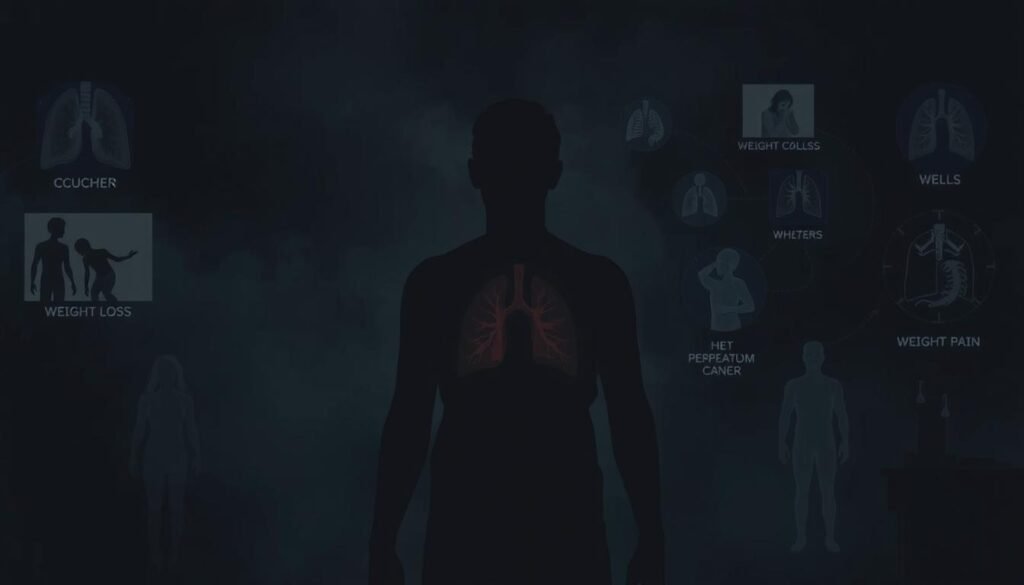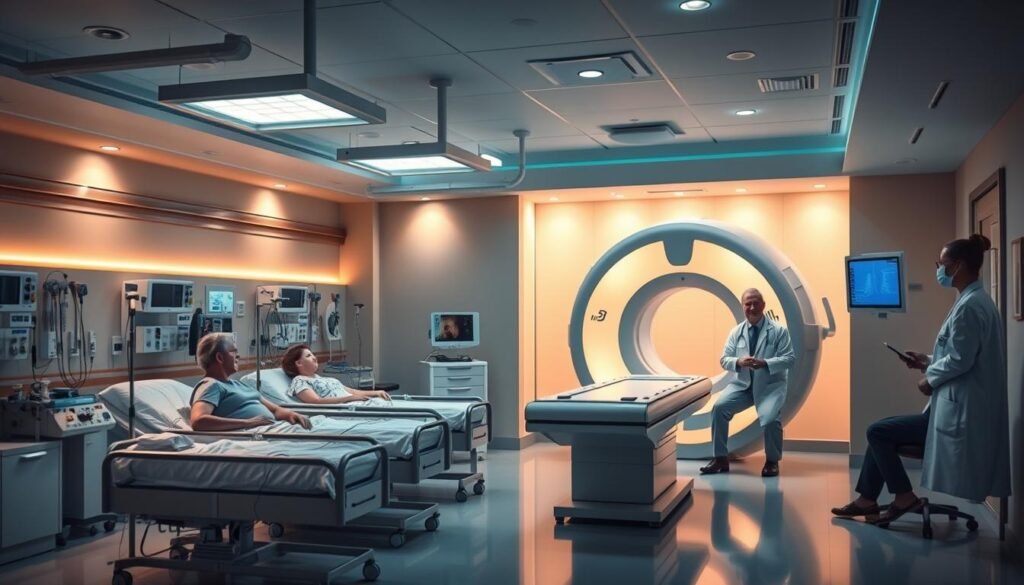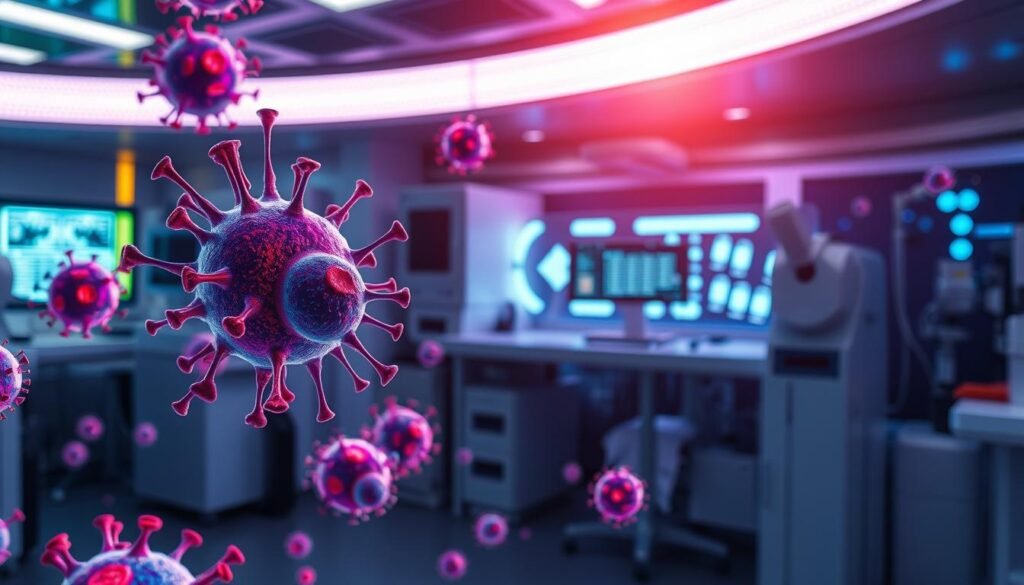Did you know nearly 60% of people with lung cancer will see it spread? This fact highlights why it’s so important to know how lung cancer spreads. It also shows what that means for treatment choices. This issue is a big worry for patients and doctors alike. Once lung cancer spreads, it makes treating it more difficult. It also greatly affects how long a patient might live.
Lung cancer usually starts in the lungs. But, it can move to places like lymph nodes and distant organs, including the brain, liver, and bones. When it becomes metastatic lung cancer, treatment plans change. Early treatments may involve surgery. But advanced stages might need chemo, radiation, or new options like immunotherapy. For more details on these treatments, visit this informative guide.
Facing lung cancer is tough, but there’s hope thanks to medical progress. These advances can help manage symptoms. They also make life better during treatment. Knowing how lung cancer spreads is key to tackling the difficult path to recovery.
Key Takeaways
- About 60% of lung cancer cases progress to metastatic stages.
- Detection of lung cancer spread significantly influences treatment options.
- Advanced treatments include chemotherapy, radiation therapy, and immunotherapy.
- Understanding the specific pathways of metastasis is essential for personalized care.
- Regular screening can aid in earlier identification of lung cancer.
Understanding Lung Cancer Metastasis
Lung cancer metastasis means cancer cells spread from their original spot to the lungs or other places. This is called metastatic lung cancer. It makes treatment and managing the disease harder. Knowing which cancers often spread to the lungs is key to understand treatment and the need for quick action.
Definition of Metastatic Lung Cancer
Metastatic lung cancer is when cancer from another part of the body reaches the lungs. This situation usually shows the cancer is in an advanced stage. Treatment becomes more difficult. Around 30–40% of people with a certain lung cancer type have metastasis at diagnosis. Sadly, only about 9% live five more years. Knowing about metastatic lung cancer shows why fast and effective treatments are crucial.
Common Types of Cancer that Spread to the Lungs
Many cancers can spread to the lungs, including:
- Breast cancer
- Colorectal cancer
- Kidney cancer
- Melanoma
- Bladder cancer
- Ovarian cancer
- Sarcoma
- Thyroid cancer
- Pancreatic cancer
- Testicular cancer
Even though different cancers can lead to lung metastasis, the treatment approaches often share similarities. A team approach is essential to create specific treatment plans for each patient. For more on treatment options, click here.
How Lung Cancer Spreads and What It Means for Treatment
Lung cancer mainly spreads through the blood and lymph systems. This lets cancer cells move to far parts of the body. Understanding how cancer spreads is key to predicting outcomes and planning treatments. It starts when cancer grows into nearby tissues, then cells break away and travel to new organs.
Mechanisms of Metastasis
The spread of cancer involves several important steps:
- Direct invasion: Cancer cells invade nearby healthy tissues.
- Detachment: Tumor cells detach from where they first formed.
- Migration: Cells move to new sites through blood and lymph vessels.
This allows lung cancer to spread fast. When it spreads, symptoms vary based on where it goes.
Common Pathways for Lung Cancer Spread
Lung cancer often spreads to certain body parts. The usual sites include:
| Metastatic Site | Description |
|---|---|
| Brain | This is common and can cause brain issues. |
| Bones | Cancer here can lead to pain and broken bones. |
| Liver | It might affect liver function and cause jaundice. |
| Nearby lymph nodes | This shows the disease is advanced and affects outlook. |
Knowing these pathways helps doctors treat lung cancer better. Patients should talk with their doctors about how cancer spread affects their treatment.
Staging of Lung Cancer
Knowing the stage of lung cancer is key to understanding how far it has spread and choosing the best treatment. It is crucial for doctors to get the stage right to customize care. They use the TNM system, which looks at tumor size, lymph node status, and if the cancer has spread.
Overview of Cancer Staging
Cancer staging shows how severe the disease is and how much it has progressed. It helps predict the patient’s outcome and decides on the treatment approach. For non-small cell lung cancer, stages go from zero to four (written as 0-IV). Each stage is defined by tumor size, the spread to nearby areas, and if it has spread to other parts of the body. Small cell lung cancer is grouped into limited or extensive stage, depending on its spread.
TNM Classification System
The TNM system is crucial for staging lung cancer. It has three parts:
- T (Tumor): This shows the size and reach of the main tumor.
- N (Nodes): This checks if nearby lymph nodes are affected.
- M (Metastasis): This looks for cancer spread to distant organs.
The TNM system has stages that describe the cancer’s extent:
| Stage | Description |
|---|---|
| Stage 0 | Carcinoma in situ, found only in the lung’s top lining or bronchus. |
| Stage I | Cancer has not spread to lymph nodes; stages 1A and 1B depend on tumor size. |
| Stage II | Involves bigger tumors and might have reached lymph nodes; split into IIA and IIB. |
| Stage III | More advanced, possibly affecting surrounding lymph nodes; includes stages IIIA, IIIB, and IIIC. |
| Stage IV | The most advanced stage, where cancer has moved to other body parts. |
Grasping the TNM system and lung cancer stages helps doctors deliver care suited to each patient’s situation.
Symptoms of Advanced Lung Cancer
It is very important to know the symptoms of advanced lung cancer early. Most times, symptoms show up when the disease is far along. People may see many signs that change how they live each day.
Common Symptoms Experienced
Those with advanced lung cancer often face these issues:
- Coughing that persists or worsens over time.
- Shortness of breath, particularly during physical activity.
- Chest pain that may intensify with certain movements.
- Unexplained weight loss and loss of appetite.
- Fatigue that does not improve with rest.
- Coughing up blood or rust-colored sputum.
These signs are key to knowing about lung cancer and other health problems.
Understanding the Impact on Quality of Life
Lung cancer symptoms greatly affect patients’ quality of life. The physical pain can lead to emotional suffering. This makes it hard to enjoy life and spend time with family.
Effective management and personalized care are essential. They help improve patients’ lives, offering better ways to cope and emotional support.

Common Sites of Lung Cancer Metastasis
Lung cancer spread can impact different parts of the body, changing how doctors treat it. Those with late-stage lung cancer often combat the movement of cancer from the lungs to other areas. The sites of lung cancer metastasis often include lymph nodes close by and far-off organs.
Nearby Lymph Nodes
Lymph nodes near the lungs are a common site for cancer’s spread. These nodes help the body fight off illnesses. When cancer reaches them, it shows the disease has advanced. Cancer moves to these nodes through the lymphatic system. This can cause swelling or lumps that doctors might find during check-ups or scans. Knowing if lymph nodes are affected is key for planning treatment. It helps decide if stronger treatment is needed.
Distant Organs Affected by Metastasis
Lung cancer can also spread to distant organs like the brain, liver, and bones. This spread can create tumors in these places, making a patient’s situation more complex. The problems seen with these metastases depend on the organ hit. They can cause neurological issues, jaundice, or bone pain, respectively. Finding these metastases early through scans is crucial. It helps in managing their effects better.
| Metastatic Site | Common Symptoms | Common Cancer Types |
|---|---|---|
| Lymph Nodes | Swelling, pain | Lung, breast, colorectal |
| Brain | Headaches, seizures, neurological deficits | Melanoma, lung, breast |
| Liver | Jaundice, abdominal pain, weight loss | Small-cell lung carcinoma, colorectal |
| Bones | Bone pain, fractures | Prostate, lung, breast |
Treatment Options for Advanced Lung Cancer
The treatment for lung cancer depends on its stage and type. With advanced lung cancer, combining different treatments is key. The goals are to limit the tumor’s growth, lessen symptoms, and better life quality.
Surgical Interventions
Surgery might not work for advanced lung cancer due to how far the tumor has spread. While it’s effective for early-stage non-small cell lung cancer (NSCLC), advanced stages pose challenges. For example, removing the affected lobe is possible in stage I NSCLC but less so as the cancer advances.
Radiation Therapy Overview
Radiation therapy is vital for advanced lung cancer. It can be done alone or with surgery or chemotherapy. Its goals are to shrink tumors, reduce pain, and ease breathing issues. For stage IIIA NSCLC that can’t be operated on, combining radiation and chemotherapy is common.
Chemotherapy and its Role
Chemotherapy is a key treatment for lung cancer, especially in later stages. It helps slow the tumor’s growth and progression. Advanced lung cancer patients see a 30-40% response to initial chemotherapy. Typically, it’s combined with radiation for stage IIIB NSCLC; targeted therapies and immunotherapy can also be included for better results.

| Treatment Stage | Surgical Interventions | Radiation Therapy | Chemotherapy |
|---|---|---|---|
| Stage 0 NSCLC | Curable by surgery alone | No need | No need |
| Stage I NSCLC | Lobectomy possible | Optional | Not commonly used |
| Stage II NSCLC | Possible before chemotherapy | Used in combination | Neoadjuvant chemotherapy common |
| Stage IIIA NSCLC | Often inoperable | Combined with chemotherapy | Typically starts with chemotherapy |
| Stage IIIB NSCLC | Inoperable | Chemo-radiation standard | Added for better outcomes |
| Stage IV NSCLC | Rarely an option | Palliative radiation possible | Frequently used, especially first-line |
Targeted Therapy for Lung Cancer
Targeted therapy is a big step forward in treating lung cancer. It offers treatments based on the disease’s genetic details. This method focuses on specific errors in cancer cells that help tumors grow. It leads to more effective and personalized treatment choices.
What is Targeted Therapy?
In targeted treatment lung cancer, therapies aim at certain gene changes or abnormal proteins. These changes can help cancer grow. The FDA has approved targeted therapies for markers like EGFR, ALK, and KRAS. These markers help decide the best treatment for patients.
How Targeted Therapy Works
Targeted therapy drugs block key enzymes needed for cancer cells to grow. For example, tyrosine kinase inhibitors come in pill form and stop harmful cell growth. But, not all lung cancer patients can use these therapies. Biomarker testing is needed to see who can benefit.
There’s also the use of ADCs and angiogenesis inhibitors. They deliver powerful drugs right to the cancer cells. This approach reduces side effects seen with traditional chemo. Such progress shows how precision medicine is boosting survival rates for lung cancer patients. Research is ongoing to find new treatments. For more details, check out this resource.
Immunotherapy in Lung Cancer Treatment
Immunotherapy is a game-changer in treating lung cancer, boosting the body’s defense against cancer cells. It activates the immune system to better identify and combat lung cancer. The method is becoming more popular, offering different treatments for various needs.
Understanding Immunotherapy
This therapy focuses on specific parts of the immune response to fight lung cancer efficiently. Treatments like checkpoint inhibitors, cancer vaccines, and adoptive T cell therapy are designed for a patient’s unique cancer type. For more details, visit this resource. Studies show its potential to improve survival rates significantly.
Benefits and Side Effects of Immunotherapy
Immunotherapy can extend life and increase the chance of remission in late-stage lung cancer. People often see better results than with old-school methods. However, it’s not without side effects. Patients might experience symptoms like those of the flu, such as:
- Fatigue
- Skin reactions
- Immune-related complications
It’s important to monitor and support patients during treatment. Knowing about the benefits and side effects helps in making informed treatment choices. This preparation is key for facing the treatment journey.

| Treatment Type | Target | Common Side Effects |
|---|---|---|
| Checkpoint Inhibitors | PD-1, PD-L1, CTLA-4 | Fatigue, rash, colitis |
| Cancer Vaccines | Specific tumor antigens | Flu-like symptoms, injection site reactions |
| Adoptive T Cell Therapy | T cells targeting cancer | Cytokine release syndrome, fatigue |
Role of Palliative Care in Lung Cancer Treatment
Palliative care plays a key role for those with lung cancer. It focuses on improving life quality by addressing physical, emotional, and spiritual needs. It helps reduce symptoms and suffering. This support extends to the family, ensuring comprehensive care.
Defining Palliative Care
Palliative care helps relieve pain and other tough symptoms of lung cancer. It also manages side effects from treatments like chemo and radiation. There’s a team dedicated to this care, including doctors, nurses, and social workers.
How Palliative Care Enhances Quality of Life
Early palliative care significantly boosts life quality for cancer patients. Studies show these patients have better end-of-life experiences and even live longer. It’s crucial for health providers to talk about palliative care early on.
This care tackles many issues for those with lung cancer. This includes:
- Managing pain and discomfort post-surgery
- Relieving symptoms like shortness of breath, fatigue, and nausea
- Providing emotional support to fight anxiety and depression
- Introducing integrative therapies like massage and mindfulness
Palliative care also includes social and spiritual support. It ensures patients get holistic treatment by working with oncologists. Getting access to this wide support is critical. Lung cancer patients often face many symptoms, with several rated as severe.
| Aspect of Palliative Care | Description |
|---|---|
| Symptom Management | Focus on relieving physical symptoms such as pain, fatigue, and nausea. |
| Emotional Support | Address psychological distress and provide access to counseling services. |
| Spiritual Care | Assist patients in finding meaning during their illness, enhancing emotional resilience. |
| Collaborative Approach | Palliative care specialists work alongside oncologists for comprehensive treatment. |
| Settings for Care | Available in hospitals, clinics, at home, or dedicated palliative care centers. |
Palliative care meets the varied needs of lung cancer patients. It supports them through their treatment, greatly improving life quality.
Knowing What to Expect from Treatment
It’s key to know what lies ahead when facing lung cancer treatment. Getting ready both emotionally and mentally can help make starting treatment easier. Patients often face different side effects from treatment. These side effects depend a lot on the treatment used. It’s important for patients and their families to know what these effects could be. This helps in managing expectations.
Potential Side Effects of Treatment
Those getting lung cancer treatment might face several side effects. These effects can change their life quality greatly. Some common side effects are:
- Fatigue
- Nausea
- Pain
- Skin irritation
- Hair loss
- Difficulties swallowing
The severity and kind of side effects can vary. It depends on the treatment approach and the patient’s health. It also depends on the lung cancer type. Treatments for non-small cell lung cancer might combine surgery, chemotherapy, and radiation therapy. Each has its own set of challenges. Knowing about these can help patients and their caregivers get ready for treatment.
Managing Expectations and Emotional Support
It’s crucial to manage expectations during lung cancer treatment. Having realistic goals can reduce stress and create a more supportive space. Emotional support is very important for patients and their families. It helps them deal with the challenges of treatment. Here are some ways to get emotional support:
- Engaging in counseling sessions
- Joining support groups specifically for lung cancer
- Participating in mindfulness and relaxation techniques
- Communicating openly with healthcare providers
Getting emotional support helps in handling hardships and building strength during tough times. A holistic approach ensures patients and their families can better manage side effects. This leads to a healthier and more balanced treatment journey.
| Type of Treatment | Potential Side Effects | Duration of Effects |
|---|---|---|
| Chemotherapy | Fatigue, nausea, hair loss | Days to weeks |
| Radiation Therapy | Fatigue, skin irritation, swallowing difficulties | Weeks to months |
| Surgery | Pain, recovery complications, fatigue | Weeks to months |
Conclusion
Lung cancer is a tough challenge, especially with how it spreads and affects treatment options. Understanding that about 53% of lung cancers have spread at diagnosis is crucial. Small Cell Lung Cancer (SCLC) is more aggressive, with two-thirds spreading beyond the lungs early on.
Facing lung cancer is scary, but finding it early can lead to better survival chances. For those with Non-Small Cell Lung Cancer (NSCLC), the 5-year survival rate jumps to 65% if it’s found early. Screening high-risk people can cut death rates by up to 20%, showing the importance of education and awareness.
Advances in research are opening up new ways to treat lung cancer, improving the lives of patients. Knowing all about how lung cancer spreads and the treatments available helps patients and their families face the disease with hope and knowledge.